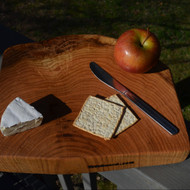Keep Your Cutting Board Clean and Safe
16th Apr 2020
Are wooden cutting boards sanitary? The answer is yes. Yet as with everything in your kitchen, including stainless steel, the boards have to be cleaned and maintained in a way that makes sense.
The main three things you have to remember are 1) keep the porous surfaces sealed, 2) wipe off food scraps immediately after use, and 3) don’t immerse your board in water.
Sealing the porous wood is done with any kitchen-safe oil. We supply a small container of raw linseed oil with every purchase, with more available in our store. Linseed oil has a slightly nutty taste that most people find pleasant, but if you don’t like it you can use another vegetable oil or mineral oil (we don't normally use mineral oil because it's derived from petroleum).
Oiling your board is especially important for end-grain cutting boards, since on these the broad surface that touches the food is on the top and bottom. Oiling the boards also slows any inflow or outflow of moisture from the boards, preventing cracking. It goes without saying that if a crack does develop you should keep it away from your food, since crevices can hide food scraps that harbor bacteria.
As for food scraps, you want to get them off when you’re through with the meal. Some foods, including tomatoes, can stain wood. Normally a wash with water and a bit of soap is enough to clean boards. If food does penetrate the layer of oil and get into a scratch or pore, you can treat the area with a mild bleach solution and leave it alone until it evaporates, according to the U.S. Department of Agriculture. The USDA points out that some people use two cutting boards, one for fruits and vegetables and one for meat and fish, so as not to spread any potentially harmful germs from meat to other foods regularly eaten raw. (For more information, read USDA’s pamphlet on cutting-board sanitation.)
It’s important not to immerse your natural wooden cutting boards in water. We don't recommend putting them in the dishwasher, since harsh detergents can remove the oil, expose pores, and inert water that will later evaporate unevenly from the wood. Cycles of heavy wetting and drying the wood can cause cracking as well as warping.
If your board develops deep or undesirable knife gouges, you can sand these down with ordinary sandpaper. Brush or blow any sanding grit off before oiling the board promptly with linseed oil.
If you've read this far, you might be wondering whether plastic boards are better for your family. It's true that plastic cutting boards are easier to clean and can be put into automatic dishwashers. Yet even plastic is susceptible to knife gouges that can harbor food and bacteria.
Keeping your natural boards clean and safe takes a little bit of effort, but the result is a beautiful, long-lasting kitchen tool that also looks beautiful on your dining-room table.
Looking for raw linseed oil to seal your cutting board? We sell small, inexpensive bottles, with free shipping. Click here.

